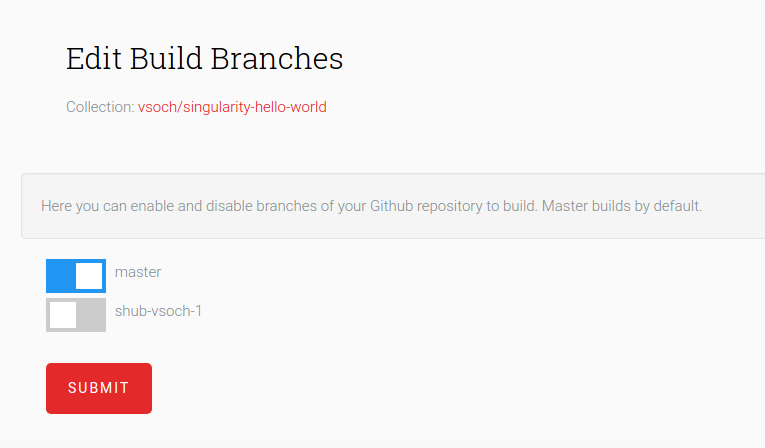Repository Connection
GitHub Repository
If you remember from the terms page, a collection is a a group of image that is built from Singularity Recipes discovered by the robots in a Github repository. One collection correspond to one repository, and may have multiple versions and tags.

You can create collections by logging in with GitHub to Singularity Hub. You are free to choose allowing Singularity Hub to build public or private collections.
Tags and Branches
By default, Singularity Hub will build from the master branch. You can choose to enable more branches in the collection settings.
Collection --> Settings --> Edit Branches
You can then turn on (and off) branches to build. This is also helpful if you want to disable a branch for building, while testing, or something like that:

Branches are a useful way for allowing automated building without having building happen for every single commit. If you have your production branch enabled for building, it will only build final images when you commit to it.
Recipes
Before we walk through a recipe example, let’s talk about how you should name and organize recipe files in your repository.
Naming Recipes
How should I name my Singularity Recipe Files?
The extension of the Singularity file will correspond with the container tag.
This is an easy way to represent the full information about the container in
the GitHub repository. If you provide a Singularity recipe without an extension,
this builds to the tag “latest.” This means that a single repository can serve
multiple container builds! For example, for username vsoch and Github repository hello-world:
[user]/[repository]
vsoch/hello-world/ (--- collection vsoch/hello-world
.git/
science/
subfolder/
Singularity (--- vsoch/hello-world:latest
Singularity.gpu (--- vsoch/hello-world:gpu
fruits/
tomatoes/
Singularity.avocado (--- vsoch/hello-world:avocado
Singularity.tomato (--- vsoch/hello-world:tomato
Notice how the folder hierarchy doesn’t matter. Recipes are found recursively, and we look for all Singularity files to build.
What if I have two recipes with the same name?
You should avoid doing this, because Singularity hub will select to build the file with more recent changes. If you use automated builds , this is the method to select recipes to build. If you want to go back in time to a particular file and commit, you should use a manual build
You can read more about builds here .
How many containers can I build at once?
Each container collection maintains its own queue, so you are allowed one build at a time per collection. This means that if you include 5 recipes in a repository, each requiring a build, all ten will be added to the queue and processed in serial.
You should now read a more detailed example for creating your recipe, naming containers, managing images or read about your options for building.